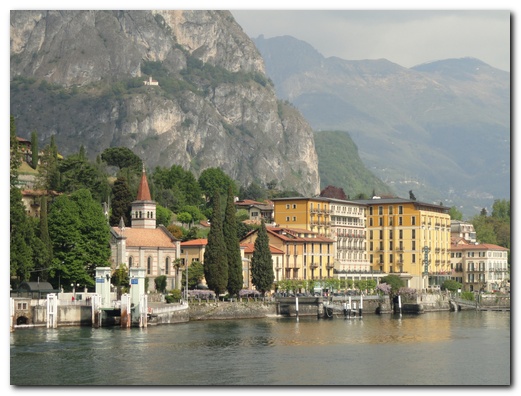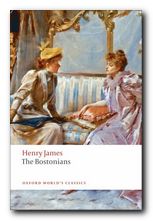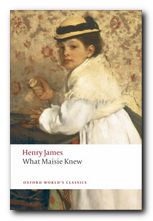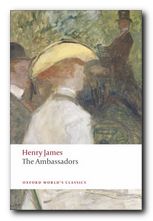tutorial, commentary, study resources, plot, and web links
Two Countries (also known as The Modern Warning) first appeared in magazine form in Harper’s New Monthly Magazine in June 1888, alongside a story by James’s contemporary William Dean Howells and a poem by Wordsworth. It was then reprinted in book form amongst The Aspern Papers and Other Tales published in England and America by Macmillan later the same year.

Cadenabbia – Lago di Como
Two Countries – critical commentary
The international theme
The tale begins well enough with an exploration of one of Henry James’s favourite themes – the differences between America and Europe – specifically Britain. The two capital cities of London and New York are represented by Grice’s work as a lawyer and Sir Rufus Chasemore’s as a member of the English parliament – though the first part of the story is set on Lago di Como in Italy.
Macarthy Grice is a pompous and self-regarding ass – but he is proudly American. He represents the new American spirit of self-reliant republican independence – a society which had thrown off the shackles of an old conservative monarchism in a revolutionary war only a hundred years before. So – Macarthy regards his sister’s alliance with the arch-Tory Sir Rufus as an act of personal and socio-political betrayal.
Sir Rufus is the epitome of arrogant English sangfroid, who hides beneath a carapace of relentless ‘good manners’, refusing to be rattled or show any discomfiture even under the most severe provocation. It is significant that he become a diplomat during the course of the story. His is the lofty superiority of a class which believes it is ‘born to rule’.
But we are led to believe that Sir Rufus takes his revenge on American attitudes in the critical work The Modern Warning he produces following his tour of the North American continent. And the warning is to modernizers in Britain. It is not clear if the book will eventually be published or not – or even if the galley proofs still exist.
The ending
This is the principal weakness of the story. We might well tolerate the uncertainty over the publication of The Modern Warning and see the story as an exploration of Anglo-American relationships. Something might even have been made of Agatha’s divided loyalties to her husband and brother.
But there is no persuasive reason given for her suicide. And it is just not plausible that she would commit such an act out of a fear of being disloyal to Macarthy. The story takes a very abrupt turn into the melodramatic at that point, from which it does not recover.
Two Countries – study resources
![]() The Complete Works of Henry James – Kindle edition – Amazon UK
The Complete Works of Henry James – Kindle edition – Amazon UK
![]() The Complete Works of Henry James – Kindle edition – Amazon US
The Complete Works of Henry James – Kindle edition – Amazon US
![]() Complete Stories 1884—1891 – Library of America – Amazon UK
Complete Stories 1884—1891 – Library of America – Amazon UK
![]() Complete Stories 1884—1891 – Library of America – Amazon US
Complete Stories 1884—1891 – Library of America – Amazon US
![]() Two Countries – read the original publication
Two Countries – read the original publication
![]() The Cambridge Companion to Henry James – Amazon UK
The Cambridge Companion to Henry James – Amazon UK
![]() Henry James at Wikipedia – biographical notes, links
Henry James at Wikipedia – biographical notes, links
![]() Henry James at Mantex – tutorials, biography, study resources
Henry James at Mantex – tutorials, biography, study resources
Two Countries – plot summary
Part I. Macarthy Grice, a pompous young American lawyer joins his mother and his attractive sister Agatha on holiday at Cadenabbia in the Italian lakes. He is annoyed to discover that they have befriended Sir Rufus Chasemore, a conservative English MP, with whom he spars verbally.
Part II. Next day his mother reveals that they know Sir Rufus quite well, and that there might be an ‘understanding’ between him and Agatha. Macarthy is angry at the idea and suggests that they leave immediately for Venice. He would prefer his sister not to marry at all, and would regard marriage to an Englishman as a form of betrayal. He reads something critical of Sir Rufus in a newspaper, and then is surprised when the Englishman seems quite unruffled by their sudden decision.
Part III. Agatha has agreed to the Venice move because she sees that encouraging Sir Rufus further would lead nowhere. Moreover, Sir Rufus does not like Americans in general. He pays court to her anew, and both reveal that they have Irish ancestors. Finally, he proposes to her, but she refuses on grounds that she must look after her mother, and not take her away from her bother. She also argues that he should visit America.
Part IV. Five years later Mrs Grice has dies, and Agatha is now Lady Chasemore and has been married for a year. She is returning to the USA on holiday for the first time. Her bother Macarthy is still unmarried and living alone. He disapproves of her marriage as an unpatriotic act. Sir Rufus has been promoted and she enjoys living in London. Sir Rufus behaves well (as a diplomat) on their visit, but privately does not like the USA.
Part V. Macarthy provides introductions for Sir Rufus, who examines American institutions, but the distance remains between the two men. When Sir Rufus makes a tour of the States and Canada alone, Agatha reconnects with New York and her brother. When Sir Rufus returns from his fact-finding tour, he declares that American women are ‘plain’ and the country as a whole is a ‘fraud’. He announces that he will write a book about America, based on his experiences. Macarthy Grice is sneeringly critical of the idea, and thinks that Britain is ‘finished’.
Part VI. A year later back in England, Agatha is horrified by the galley proofs of Sir Rufus’s book. He has produced a scathing critique of American ‘democracy’ as a warning to the British. This causes Agatha to defend America and what it stands for.
Part VII. When Sir Rufus returns the next day he cannot understand her objections. She knows that Macarthy will feel deeply wounded and betrayed. She argues with Sir Rufus late into the night, and appeals to him on the grounds of her Irish ancestry. Eventually he agrees not to publish The MOdern Warning, even though ‘his country’ would be the loser.
Following this Agatha admires her husband for the sacrifice he has made – and made with such good grace. However, she worries that she will never know his true thoughts and feelings, because they are eternally hidden behind his ‘good manners’. Then she begins to feel guilty for having robbed him of the opportunity to make a contribution to his country and for being the source of a disappointment to him.
Finally, she changes her mind completely and insists that he publish his book. Her brother Macarthy visits London on holiday, but is met with the news that she has committed suicide by taking poison. Sir Rufus accuses Macarthy of ‘killing’ her because she was so frightened by the prospect of facing him, but the two men are later reconciled in their common grief. Macarthy Grice goes to the continent for the remainder of his holiday, and the book may or may not be published.
Principal characters
| Macarthy Grice | a young, pompous, and self-regarding American lawyer |
| Agatha Grice | his attractive younger sister |
| Mrs Grice | his mother |
| Sir Rufus Chasemore | a conservative English MP |
| Lady Bolitho | Chasemore’s sister |

Henry James – portrait by John Singer Sargeant
Further reading
Biographical
![]() Theodora Bosanquet, Henry James at Work, University of Michigan Press, 2007.
Theodora Bosanquet, Henry James at Work, University of Michigan Press, 2007.
![]() F.W. Dupee, Henry James: Autobiography, Princeton University Press, 1983.
F.W. Dupee, Henry James: Autobiography, Princeton University Press, 1983.
![]() Leon Edel, Henry James: A Life, HarperCollins, 1985.
Leon Edel, Henry James: A Life, HarperCollins, 1985.
![]() Philip Horne (ed), Henry James: A Life in Letters, Viking/Allen Lane, 1999.
Philip Horne (ed), Henry James: A Life in Letters, Viking/Allen Lane, 1999.
![]() Henry James, The Letters of Henry James, Adamant Media Corporation, 2001.
Henry James, The Letters of Henry James, Adamant Media Corporation, 2001.
![]() Fred Kaplan, Henry James: The Imagination of Genius, Johns Hopkins University Press, 1999
Fred Kaplan, Henry James: The Imagination of Genius, Johns Hopkins University Press, 1999
![]() F.O. Matthieson (ed), The Notebooks of Henry James, Oxford University Press, 1988.
F.O. Matthieson (ed), The Notebooks of Henry James, Oxford University Press, 1988.
Critical commentary
![]() Elizabeth Allen, A Woman’s Place in the Novels of Henry James London: Macmillan Press, 1983.
Elizabeth Allen, A Woman’s Place in the Novels of Henry James London: Macmillan Press, 1983.
![]() Ian F.A. Bell, Henry James and the Past, London: Palgrave Macmillan, 1993.
Ian F.A. Bell, Henry James and the Past, London: Palgrave Macmillan, 1993.
![]() Millicent Bell, Meaning in Henry James, Cambridge (MA): Harvard University Press, 1993.
Millicent Bell, Meaning in Henry James, Cambridge (MA): Harvard University Press, 1993.
![]() Harold Bloom (ed), Modern Critical Views: Henry James, Chelsea House Publishers, 1991.
Harold Bloom (ed), Modern Critical Views: Henry James, Chelsea House Publishers, 1991.
![]() Kirstin Boudreau, Henry James’s Narrative Technique, Macmillan, 2010.
Kirstin Boudreau, Henry James’s Narrative Technique, Macmillan, 2010.
![]() J. Donald Crowley and Richard A. Hocks (eds), The Wings of the Dove, New York: W.W. Norton and Company, 1978.
J. Donald Crowley and Richard A. Hocks (eds), The Wings of the Dove, New York: W.W. Norton and Company, 1978.
![]() Victoria Coulson, Henry James, Women and Realism, Cambridge University Press, 2009.
Victoria Coulson, Henry James, Women and Realism, Cambridge University Press, 2009.
![]() Daniel Mark Fogel, A Companion to Henry James Studies, Greenwood Press, 1993.
Daniel Mark Fogel, A Companion to Henry James Studies, Greenwood Press, 1993.
![]() Virginia C. Fowler, Henry James’s American Girl: The Embroidery on the Canvas, Madison (Wis): University of Wisconsin Press, 1984.
Virginia C. Fowler, Henry James’s American Girl: The Embroidery on the Canvas, Madison (Wis): University of Wisconsin Press, 1984.
![]() Jonathan Freedman, The Cambridge Companion to Henry James, Cambridge University Press, 1998.
Jonathan Freedman, The Cambridge Companion to Henry James, Cambridge University Press, 1998.
![]() Judith Fryer, The Faces of Eve: Women in the Nineteenth Century American Novel, Oxford: Oxford University Press, 1976
Judith Fryer, The Faces of Eve: Women in the Nineteenth Century American Novel, Oxford: Oxford University Press, 1976
![]() Roger Gard (ed), Henry James: The Critical Heritage, London: Routledge, 1968.
Roger Gard (ed), Henry James: The Critical Heritage, London: Routledge, 1968.
![]() Tessa Hadley, Henry James and the Imagination of Pleasure, Cambridge University Press, 2009.
Tessa Hadley, Henry James and the Imagination of Pleasure, Cambridge University Press, 2009.
![]() Barbara Hardy, Henry James: The Later Writing (Writers & Their Work), Northcote House Publishers, 1996.
Barbara Hardy, Henry James: The Later Writing (Writers & Their Work), Northcote House Publishers, 1996.
![]() Richard A. Hocks, Henry James: A study of the short fiction, New York: Twayne Publishers, 1990.
Richard A. Hocks, Henry James: A study of the short fiction, New York: Twayne Publishers, 1990.
![]() Donatella Izzo, Portraying the Lady: Technologies of Gender in the Short Stories of Henry James, University of Nebraska Press, 2002.
Donatella Izzo, Portraying the Lady: Technologies of Gender in the Short Stories of Henry James, University of Nebraska Press, 2002.
![]() Colin Meissner, Henry James and the Language of Experience, Cambridge University Press, 2009
Colin Meissner, Henry James and the Language of Experience, Cambridge University Press, 2009
![]() John Pearson (ed), The Prefaces of Henry James, Pennsylvania State University Press, 1993.
John Pearson (ed), The Prefaces of Henry James, Pennsylvania State University Press, 1993.
![]() Richard Poirer, The Comic Sense of Henry James, Oxford: Oxford University Press, 1967.
Richard Poirer, The Comic Sense of Henry James, Oxford: Oxford University Press, 1967.
![]() Hugh Stevens, Henry James and Sexuality, Cambridge University Press, 1998.
Hugh Stevens, Henry James and Sexuality, Cambridge University Press, 1998.
![]() Merle A. Williams, Henry James and the Philosophical Novel, Cambridge University Press, 1993.
Merle A. Williams, Henry James and the Philosophical Novel, Cambridge University Press, 1993.
![]() Judith Woolf, Henry James: The Major Novels, Cambridge University Press, 1991.
Judith Woolf, Henry James: The Major Novels, Cambridge University Press, 1991.
![]() Ruth Yeazell (ed), Henry James: A Collection of Critical Essays, Longmans, 1994.
Ruth Yeazell (ed), Henry James: A Collection of Critical Essays, Longmans, 1994.
Other works by Henry James
 The Bostonians (1886) is a novel about the early feminist movement. The heroine Verena Tarrant is an ‘inspirational speaker’ who is taken under the wing of Olive Chancellor, a man-hating suffragette and radical feminist. Trying to pull her in the opposite direction is Basil Ransom, a vigorous young man from the South to whom Verena becomes more and more attracted. The dramatic contest to possess her is played out with some witty and often rather sardonic touches, and as usual James keeps the reader guessing about the outcome until the very last page.
The Bostonians (1886) is a novel about the early feminist movement. The heroine Verena Tarrant is an ‘inspirational speaker’ who is taken under the wing of Olive Chancellor, a man-hating suffragette and radical feminist. Trying to pull her in the opposite direction is Basil Ransom, a vigorous young man from the South to whom Verena becomes more and more attracted. The dramatic contest to possess her is played out with some witty and often rather sardonic touches, and as usual James keeps the reader guessing about the outcome until the very last page.
![]() Buy the book at Amazon UK
Buy the book at Amazon UK
![]() Buy the book at Amazon US
Buy the book at Amazon US
 What Masie Knew (1897) A young girl is caught between parents who are in the middle of personal conflict, adultery, and divorce. Can she survive without becoming corrupted? It’s touch and go – and not made easier for the reader by the attentions of an older man who decides to ‘look after’ her. This comes from the beginning of James’s ‘Late Phase’, so be prepared for longer and longer sentences. In fact it’s said that whilst composing this novel, James switched from writing longhand to using dictation – and it shows if you look carefully enough – part way through the book.
What Masie Knew (1897) A young girl is caught between parents who are in the middle of personal conflict, adultery, and divorce. Can she survive without becoming corrupted? It’s touch and go – and not made easier for the reader by the attentions of an older man who decides to ‘look after’ her. This comes from the beginning of James’s ‘Late Phase’, so be prepared for longer and longer sentences. In fact it’s said that whilst composing this novel, James switched from writing longhand to using dictation – and it shows if you look carefully enough – part way through the book.
![]() Buy the book at Amazon UK
Buy the book at Amazon UK
![]() Buy the book at Amazon US
Buy the book at Amazon US
 The Ambassadors (1903) Lambert Strether is sent from America to Paris to recall Chadwick Newsome, a young man who is reported to be compromising himself by an entanglement with a wicked woman. However, Strether’s mission fails when he is seduced by the social pleasures of the European capital, and he takes Newsome’s side. So a second ambassador is dispatched in the form of the more determined Sarah Pocock. She delivers an ultimatum which is resisted by the two young men, but then an accident reveals unpleasant truths to Strether, who is faced by a test of loyalty between old Europe and the new USA. This edition presents the latest scholarship on James and includes an introduction, notes, selected criticism, a text summary and a chronology of James’s life and times.
The Ambassadors (1903) Lambert Strether is sent from America to Paris to recall Chadwick Newsome, a young man who is reported to be compromising himself by an entanglement with a wicked woman. However, Strether’s mission fails when he is seduced by the social pleasures of the European capital, and he takes Newsome’s side. So a second ambassador is dispatched in the form of the more determined Sarah Pocock. She delivers an ultimatum which is resisted by the two young men, but then an accident reveals unpleasant truths to Strether, who is faced by a test of loyalty between old Europe and the new USA. This edition presents the latest scholarship on James and includes an introduction, notes, selected criticism, a text summary and a chronology of James’s life and times.
![]() Buy the book at Amazon UK
Buy the book at Amazon UK
![]() Buy the book at Amazon US
Buy the book at Amazon US
Henry James – web links
![]() Henry James at Mantex
Henry James at Mantex
Biographical notes, study guides, tutorials on the Complete Tales, book reviews. bibliographies, and web links.
![]() The Complete Works
The Complete Works
Sixty books in one 13.5 MB Kindle eBook download for £1.92 at Amazon.co.uk. The complete novels, stories, travel writing, and prefaces. Also includes his autobiographies, plays, and literary criticism – with illustrations.
![]() The Ladder – a Henry James website
The Ladder – a Henry James website
A collection of eTexts of the tales, novels, plays, and prefaces – with links to available free eTexts at Project Gutenberg and elsewhere.
![]() A Hyper-Concordance to the Works
A Hyper-Concordance to the Works
Japanese-based online research tool that locates the use of any word or phrase in context. Find that illusive quotable phrase.
![]() The Henry James Resource Center
The Henry James Resource Center
A web site with biography, bibliographies, adaptations, archival resources, suggested reading, and recent scholarship.
![]() Online Books Page
Online Books Page
A collection of online texts, including novels, stories, travel writing, literary criticism, and letters.
![]() Henry James at Project Gutenberg
Henry James at Project Gutenberg
A major collection of eTexts, available in a variety of eBook formats.
![]() The Complete Letters
The Complete Letters
Archive of the complete correspondence (1855-1878) work in progress – published by the University of Nebraska Press.
![]() The Scholar’s Guide to Web Sites
The Scholar’s Guide to Web Sites
An old-fashioned but major jumpstation – a website of websites and resouces.
![]() Henry James – The Complete Tales
Henry James – The Complete Tales
Tutorials on the complete collection of over one hundred tales, novellas, and short stories.
![]() Henry James on the Internet Movie Database
Henry James on the Internet Movie Database
Adaptations of James’s novels and stories for the cinema and television – in various languages. Full details of directors and actors, production features, film reviews, box office, and even quizzes.
© Roy Johnson 2013
More tales by James
More on literature
More on the novella
More on literary studies
More on short stories
